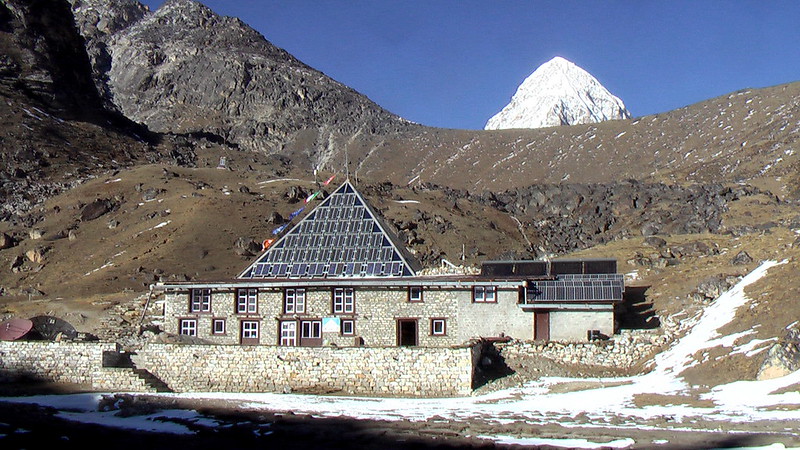The Enigma of Mount Everest's Peculiar Climate: How Himalayan Glaciers Defend Against Soaring Temperatures

At night, the Pyramid Observatory becomes a crucial asset for researchers from the Institute of Science and Technology Austria (ISTA). The climate station tracks hourly meteorological data and has been doing so for nearly three decades. From this location, the magnificence of Pumori Peak in Nepal adorns the horizon. Credit: Franco Salerno
The robust glaciers of the Himalayas are putting up a fight, striving to preserve their icy integrity. However, one question remains: for how long can they withstand the increasing heat? This question is the focus of an international team of researchers, co-steered by Professor Francesca Pellicciotti of the Institute of Science and Technology Austria (ISTA). A remarkable phenomenon has been discovered: the escalating global temperatures have triggered a reactionary cooling of the air surrounding the ice surfaces of Himalayan glaciers. These cold winds may potentially aid the conservation of the glaciers and the ecosystems they support. These findings, present throughout the Himalayan range, are published in Nature Geoscience.
Could global warming hasten the melting of Himalayan glaciers, much like ice cream melting on a scorching summer day? Previously, it was shown by scientists that global warming has a stronger effect on mountaintops, causing them to heat up faster. However, a high-altitude climate station at the base of Mount Everest in Nepal discovered an unexpected occurrence. Recorded average surface air temperatures remained oddly stable rather than rising as anticipated. How should this data be understood?
Himalayan glaciers are responding to global warming. A schematic diagram provides visual representation of the air cooling surrounding these glaciers. Credit: Salerno/Guyennon/Pellicciotti/Nature Geoscience
The Pyramid International Laboratory/Observatory climate station, located at an icy elevation (5050 m) on the south-facing slopes of Mount Everest neighboring the Khumbu and Lobuche glaciers, has systematically tracked hourly meteorological data for nearly three decades. An international research team, headed by the new ISTA Professor Francesca Pellicciotti and National Research Council of Italy (CNR) researchers Franco Salerno and Nicolas Guyennon, has broken the code.
Increasing global temperatures trigger a cooling response in the glaciers, stimulating cold — katabatic — winds to flow downhill. But for how long can the glaciers balance the impacts of global warming by cooling themselves? And what characteristics allow them to do so?
The Devil Is in the Detail
To understand the phenomenon, it was important to sift through the data meticulously. "We came to understand that the overall temperature averages appeared stable for one simple reason. While the minimum temperatures have been gradually rising, the summertime surface temperature maxima have been consistently dipping," Salerno explains.
The glaciers respond to warming temperatures by augmenting their heat exchange with the surface, explains Pellicciotti. The surface air mass ends up significantly cooler due to the increased temperature contrast between the warmer environmental air over the glacier and the air mass directly contacting the glacial surface.
"The enhanced turbulent heat exchange at the glacial surface and the intensifying cooling of the surface air mass lead to dense, cool, dry surface air masses flowing downhill, cooling the lower glacier portions and nearby ecosystems," Pellicciotti says. Beyond ground observations solely available at Pyramid, the team interpreted the global climate and weather reanalysis ERA5-Land. The interpretation confirmed that the phenomenon of global warming-induced katabatic winds extented beyond Mount Everest to the entire Himalayan range."
From left to right: Nicolas Guyennon (IRSA-CNR), Francesca Pellicciotti (ISTA), Thomas Shaw (ISTA) are seen discussing their findings. Credit: Franco Salerno
Ultimately, the researchers aim to understand which glaciers are capable of reacting in this manner to global warming and determine how long they can do so. "While some glaciers are currently facing significant changes, the glaciers in High-Mountain Asia, the Third Pole, are enormous and hold more ice masses, leading to longer response times. We may be fortunate enough to have the opportunity to 'rescue' these glaciers."
Thus, Pellicciotti and her team will soon investigate whether the world’s only stable or growing glaciers in the Pamir and Karakoram mountains, to the north-west of the Himalayas, are also reacting to global warming by blowing cold winds down their slopes. “The slopes of the Pamir and Karakoram glaciers are generally flatter than in the Himalayas. Thus, we hypothesize that the cold winds might act to cool the glaciers themselves rather than reaching lower down into the surrounding environments. We will be able to tell in the next couple of years,” says Pellicciotti.
“We believe that the katabatic winds are the response of healthy glaciers to rising global temperatures and that this phenomenon could help preserve the permafrost and surrounding vegetation,” says Guyennon. Glaciers are indeed essential in maintaining the water security in their ecosystems.
The Pyramid Observatory covered in snow. Important for the researchers from the Institute of Science and Technology Austria (ISTA): The climate station has recorded hourly meteorological data for nearly three decades. Credit: Franco Salerno
But how long can healthy glaciers fight back? The glaciers on the southern Himalayan slopes are classical examples of “accumulation-ablation glaciers”: they accumulate mass at high altitudes from the Indian subcontinent’s summer monsoons and, at the same time, lose mass from the continuous melting.
However, the katabatic winds are now shifting this balance: the colder air masses flowing down from the glaciers are lowering the altitude at which precipitation takes place. This leads to the glaciers missing a key mass input while they continue to melt. Thus, perceived cool temperatures flowing down from glaciers are an emergency reaction to global warming rather than an indicator of glacier long-term stability.
Does this mean that the glaciers are approaching their preservation tipping point? “They are in some places, but we do not know where and how,” says Pellicciotti. Yet, she does not lose heart easily: “Even if the glaciers can’t preserve themselves forever, they might still preserve the environment around them for some time. Thus, we call for more multidisciplinary research approaches to converge efforts toward explaining the effects of global warming,” she concludes. These efforts could prove instrumental in changing the course of human-caused climate change.




